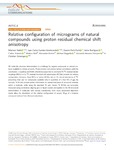Mostrar o rexistro simple do ítem
Relative Configuration of Micrograms of Natural Compounds Using Proton Residual Chemical Shift Anisotropy
| dc.contributor.author | Nath, Nilamoni | |
| dc.contributor.author | Fuentes-Monteverde, Juan Carlos | |
| dc.contributor.author | Pech-Puch, Dawrin | |
| dc.contributor.author | Rodríguez, Jaime | |
| dc.contributor.author | Jiménez, Carlos | |
| dc.contributor.author | Noll, Markus | |
| dc.contributor.author | Kreiter, Alexander | |
| dc.contributor.author | Reggelin, Michael | |
| dc.contributor.author | Navarro-Vázquez, Armando | |
| dc.contributor.author | Griesinger, Christian | |
| dc.date.accessioned | 2020-10-05T10:42:33Z | |
| dc.date.available | 2020-10-05T10:42:33Z | |
| dc.date.issued | 2020-09-01 | |
| dc.identifier.citation | Nath, N., Fuentes-Monteverde, J.C., Pech-Puch, D. et al. Relative configuration of micrograms of natural compounds using proton residual chemical shift anisotropy. Nat Commun 11, 4372 (2020). https://doi.org/10.1038/s41467-020-18093-5 | es_ES |
| dc.identifier.issn | 2041-1723 | |
| dc.identifier.uri | http://hdl.handle.net/2183/26329 | |
| dc.description.abstract | [Abstract] 3D molecular structure determination is a challenge for organic compounds or natural products available in minute amounts. Proton/proton and proton/carbon correlations yield the constitution. J couplings and NOEs oftentimes supported by one-bond 1H,13C residual dipolar couplings (RDCs) or by 13C residual chemical shift anisotropies (RCSAs) provide the relative configuration. However, these RDCs or carbon RCSAs rely on 1% natural abundance of 13C preventing their use for compounds available only in quantities of a few 10’s of µgs. By contrast, 1H RCSAs provide similar information on spatial orientation of structural moieties within a molecule, while using the abundant 1H spin. Herein, 1H RCSAs are accurately measured using constrained aligning gels or liquid crystals and applied to the 3D structural determination of molecules with varying complexities. Even more, deuterated alignment media allow the elucidation of the relative configuration of around 35 µg of a briarane compound isolated from Briareum asbestinum. | es_ES |
| dc.description.sponsorship | This work was supported by the Max Planck Society and grew out of a collaboration in the context of the Forschergruppe (FOR 934) continued now by the DFG (Gr1211/19–1 and Re1007/9–1)/CAPES 418729698 project. N.N. gratefully acknowledges the financial support by SERB, New Delhi for ECR Grant with File No.: ECR/2017/001811. This work was also funded by grants RTI2018-093634-B-C22 from the State Agency for Research (AEI) of Spain, both co-funded by the FEDER Programme from the European Union, BLUEBIOLAB (0474_BLUEBIOLAB_1_E), Programme INTERREG V A of Spain-Portugal (POCTEP) and GRC2018/039 and Agrupación Estratégica CICA-INIBIC ED431E 2018/03 from Xunta de Galicia. C.J., J.R., and D.P.P. acknowledge CESGA for the computational support. J.C.F. acknowledges predoctoral research stay grant Inditex-UDC. D.P.P. received a fellowship from the program National Council of Science and Technology (CONACYT) of Mexico and the Secretariat of Research, Innovation and Higher Education (SIIES) of Yucatan (Mexico). We also thank Dr. G. Jithender Reddy for one isotropic measurement. We also thank Dr. Christian Schmidt for his cooperation in the manufacturing of micro stretching device. ANV thanks CNPq for a research fellowship and financial support M(426216/2018–0) | es_ES |
| dc.description.sponsorship | German Research Foundation; Gr1211/19–1 | es_ES |
| dc.description.sponsorship | German Research Foundation; Re1007/9–1 | es_ES |
| dc.description.sponsorship | Brasil. Coordenação de Aperfeiçoamento de Pessoal de Nível Superior (CAPES); 418729698 | es_ES |
| dc.description.sponsorship | República de la India. Science and Engineering Research Board; ECR/2017/001811 | es_ES |
| dc.description.sponsorship | Xunta de Galicia; 0474_BLUEBIOLAB_1_E | es_ES |
| dc.description.sponsorship | Xunta de Galicia; GRC2018/039 | es_ES |
| dc.description.sponsorship | Xunta de Galicia; ED431E 2018/03 | es_ES |
| dc.description.sponsorship | Brasil. Conselho Nacional de Desenvolvimento Científico e Tecnológico; M(426216/2018–0) | |
| dc.language.iso | eng | es_ES |
| dc.publisher | Nature | es_ES |
| dc.relation | info:eu-repo/grantAgreement/AEI/Plan Estatal de Investigación Científica y Técnica y de Innovación 2017-2020/RTI2018-093634-B-C22/ES/FACTORES DE VIRULENCIA BACTERIANOS COMO DIANAS TERAPEUTICAS EN PECES: CARACTERIZACION DE SIDEROFOROS Y DESARROLLO DE NUEVOS TRATAMIENTOS CONTRA FORUNCULOSIS Y TENACIBACULOSIS | |
| dc.relation.uri | https://doi.org/10.1038/s41467-020-18093-5 | es_ES |
| dc.rights | Atribución 4.0 Internacional | es_ES |
| dc.rights.uri | http://creativecommons.org/licenses/by/4.0/ | * |
| dc.subject | NMR | es_ES |
| dc.subject | Structure elucidation | es_ES |
| dc.subject | RCSA | es_ES |
| dc.subject | Stereochemistry | es_ES |
| dc.subject | Briarane | es_ES |
| dc.title | Relative Configuration of Micrograms of Natural Compounds Using Proton Residual Chemical Shift Anisotropy | es_ES |
| dc.type | info:eu-repo/semantics/article | es_ES |
| dc.rights.access | info:eu-repo/semantics/openAccess | es_ES |
| UDC.journalTitle | Nature Communications | es_ES |
| UDC.volume | 11 | es_ES |
| UDC.startPage | 4372 | es_ES |
| dc.identifier.doi | 10.1038/s41467-020-18093-5 |
Ficheiros no ítem
Este ítem aparece na(s) seguinte(s) colección(s)
-
GI- Quimolmat - Artigos [110]







